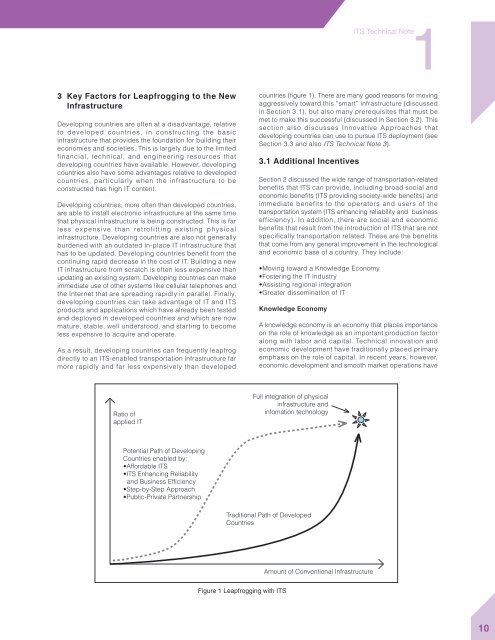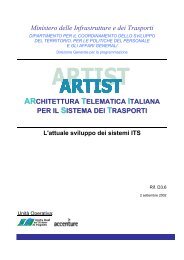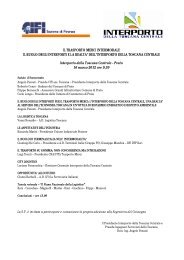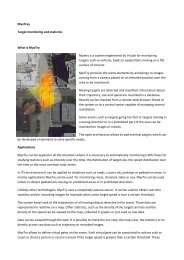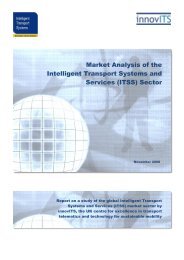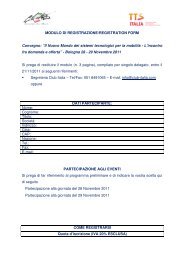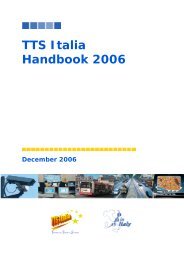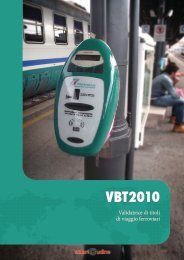ITS for Developing Countries ITS for Developing Countries - TTS Italia
ITS for Developing Countries ITS for Developing Countries - TTS Italia
ITS for Developing Countries ITS for Developing Countries - TTS Italia
You also want an ePaper? Increase the reach of your titles
YUMPU automatically turns print PDFs into web optimized ePapers that Google loves.
1<br />
<strong>ITS</strong> Technical Note<br />
3 Key Factors <strong>for</strong> Leapfrogging to the New<br />
Infrastructure<br />
<strong>Developing</strong> countries are often at a disadvantage, relative<br />
to developed countries, in constructing the basic<br />
infrastructure that provides the foundation <strong>for</strong> building their<br />
economies and societies. This is largely due to the limited<br />
financial, technical, and engineering resources that<br />
developing countries have available. However, developing<br />
countries also have some advantages relative to developed<br />
countries, particularly when the infrastructure to be<br />
constructed has high IT content.<br />
<strong>Developing</strong> countries, more often than developed countries,<br />
are able to install electronic infrastructure at the same time<br />
that physical infrastructure is being constructed. This is far<br />
less expensive than retrofitting existing physical<br />
infrastructure. <strong>Developing</strong> countries are also not generally<br />
burdened with an outdated in-place IT infrastructure that<br />
has to be updated. <strong>Developing</strong> countries benefit from the<br />
continuing rapid decrease in the cost of IT. Building a new<br />
IT infrastructure from scratch is often less expensive than<br />
updating an existing system. <strong>Developing</strong> countries can make<br />
immediate use of other systems like cellular telephones and<br />
the Internet that are spreading rapidly in parallel. Finally,<br />
developing countries can take advantage of IT and <strong>ITS</strong><br />
products and applications which have already been tested<br />
and deployed in developed countries and which are now<br />
mature, stable, well understood, and starting to become<br />
less expensive to acquire and operate.<br />
As a result, developing countries can frequently leapfrog<br />
directly to an <strong>ITS</strong>-enabled transportation infrastructure far<br />
more rapidly and far less expensively than developed<br />
countries (figure 1). There are many good reasons <strong>for</strong> moving<br />
aggressively toward this “smart” infrastructure (discussed<br />
in Section 3.1), but also many prerequisites that must be<br />
met to make this successful (discussed in Section 3.2). This<br />
section also discusses Innovative Approaches that<br />
developing countries can use to pursue <strong>ITS</strong> deployment (see<br />
Section 3.3 and also <strong>ITS</strong> Technical Note 3).<br />
3.1 Additional Incentives<br />
Section 2 discussed the wide range of transportation-related<br />
benefits that <strong>ITS</strong> can provide, including broad social and<br />
economic benefits (<strong>ITS</strong> providing society-wide benefits) and<br />
immediate benefits to the operators and users of the<br />
transportation system (<strong>ITS</strong> enhancing reliability and business<br />
efficiency). In addition, there are social and economic<br />
benefits that result from the introduction of <strong>ITS</strong> that are not<br />
specifically transportation related. These are the benefits<br />
that come from any general improvement in the technological<br />
and economic base of a country. They include:<br />
•Moving toward a Knowledge Economy<br />
•Fostering the IT industry<br />
•Assisting regional integration<br />
•Greater dissemination of IT<br />
Knowledge Economy<br />
A knowledge economy is an economy that places importance<br />
on the role of knowledge as an important production factor<br />
along with labor and capital. Technical innovation and<br />
economic development have traditionally placed primary<br />
emphasis on the role of capital. In recent years, however,<br />
economic development and smooth market operations have<br />
Ratio of<br />
applied IT<br />
Full integration of physical<br />
infrastructure and<br />
infomation technology<br />
Potential Path of <strong>Developing</strong><br />
<strong>Countries</strong> enabled by:<br />
•Af<strong>for</strong>dable <strong>ITS</strong><br />
•<strong>ITS</strong> Enhancing Reliability<br />
and Business Efficiency<br />
•Step-by-Step Approach<br />
•Public-Private Partnership<br />
Traditional Path of Developed<br />
<strong>Countries</strong><br />
Amount of Conventional Infrastructure<br />
Figure 1 Leapfrogging with <strong>ITS</strong><br />
10


